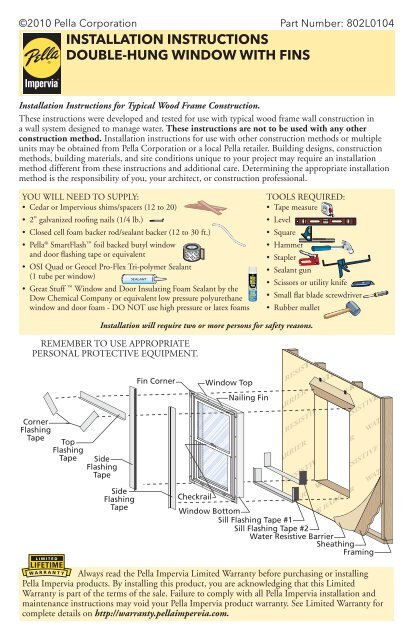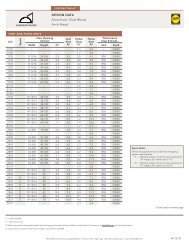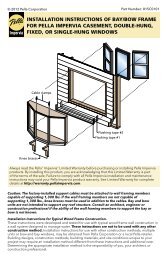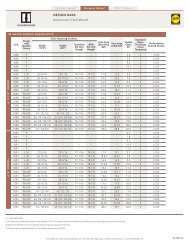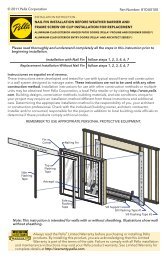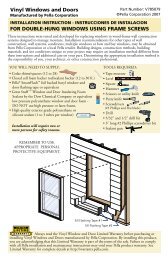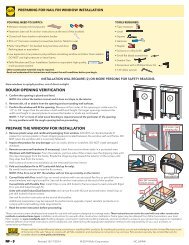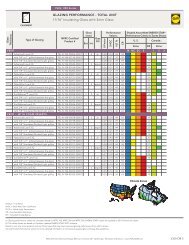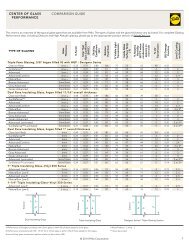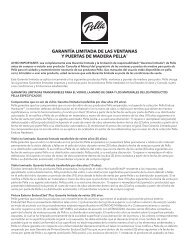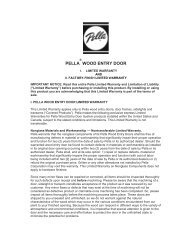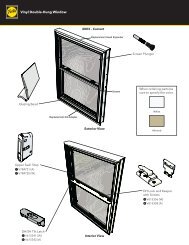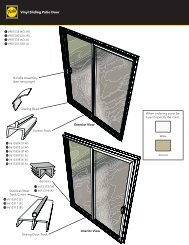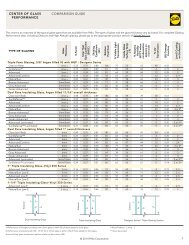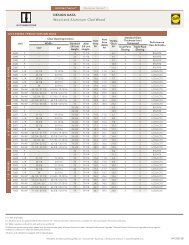installation instructions double-hung window with fins - Pella.com
installation instructions double-hung window with fins - Pella.com
installation instructions double-hung window with fins - Pella.com
Create successful ePaper yourself
Turn your PDF publications into a flip-book with our unique Google optimized e-Paper software.
©2010 <strong>Pella</strong> Corporation<br />
INSTALLATION INSTRUCTIONS<br />
DOUBLE-HUNG WINDOW WITH FINS<br />
Part Number: 802L0104<br />
Installation Instructions for Typical Wood Frame Construction.<br />
These <strong>instructions</strong> were developed and tested for use <strong>with</strong> typical wood frame wall construction in<br />
a wall system designed to manage water. These <strong>instructions</strong> are not to be used <strong>with</strong> any other<br />
construction method. Installation <strong>instructions</strong> for use <strong>with</strong> other construction methods or multiple<br />
units may be obtained from <strong>Pella</strong> Corporation or a local <strong>Pella</strong> retailer. Building designs, construction<br />
methods, building materials, and site conditions unique to your project may require an <strong>installation</strong><br />
method different from these <strong>instructions</strong> and additional care. Determining the appropriate <strong>installation</strong><br />
method is the responsibility of you, your architect, or construction professional.<br />
YOU WILL NEED TO SUPPLY:<br />
• Cedar or Impervious shims/spacers (12 to 20)<br />
• 2" galvanized roofing nails (1/4 lb.)<br />
• Closed cell foam backer rod/sealant backer (12 to 30 ft.)<br />
• <strong>Pella</strong> ® SmartFlash foil backed butyl <strong>window</strong><br />
and door flashing tape or equivalent<br />
• OSI Quad or Geocel Pro-Flex Tri-polymer Sealant<br />
(1 tube per <strong>window</strong>)<br />
<br />
• Great Stuff Window and Door Insulating Foam Sealant by the<br />
Dow Chemical Company or equivalent low pressure polyurethane<br />
<strong>window</strong> and door foam - DO NOT use high pressure or latex foams<br />
TOOLS REQUIRED:<br />
• Tape measure<br />
• Level<br />
• Square<br />
• Hammer<br />
• Stapler<br />
• Sealant gun<br />
• Scissors or utility knife<br />
• Small flat blade screwdriver<br />
• Rubber mallet<br />
Installation will require two or more persons for safety reasons.<br />
REMEMBER TO USE APPROPRIATE<br />
PERSONAL PROTECTIVE EQUIPMENT.<br />
Fin Corner<br />
Window Top<br />
Nailing Fin<br />
Corner<br />
Flashing<br />
Tape<br />
Top<br />
Flashing<br />
Tape<br />
Side<br />
Flashing<br />
Tape<br />
Side<br />
Flashing<br />
Tape<br />
Checkrail<br />
Window Bottom<br />
Sill Flashing Tape #1<br />
Sill Flashing Tape #2<br />
Water Resistive Barrier<br />
Sheathing<br />
Framing<br />
Always read the <strong>Pella</strong> Impervia Limited Warranty before purchasing or installing<br />
<strong>Pella</strong> Impervia products. By installing this product, you are acknowledging that this Limited<br />
Warranty is part of the terms of the sale. Failure to <strong>com</strong>ply <strong>with</strong> all <strong>Pella</strong> Impervia <strong>installation</strong> and<br />
maintenance <strong>instructions</strong> may void your <strong>Pella</strong> Impervia product warranty. See Limited Warranty for<br />
<strong>com</strong>plete details on http://warranty.pellaimpervia.<strong>com</strong>.
1 ROUGH OPENING PREPARATION<br />
A. Confirm the opening is plumb and level.<br />
Note: It is critical that the bottom is level.<br />
B. Confirm the <strong>window</strong> will fit the opening. Measure all four sides<br />
of the opening to make sure it is 1/2" larger than the <strong>window</strong> in<br />
both width and height. On larger openings measure the width<br />
and height in several places to ensure the header or studs are not<br />
bowed.<br />
Note: 1-1/2" or more of solid wood blocking is required around<br />
the perimeter of the opening. Fix any problems <strong>with</strong> the rough<br />
opening before proceeding.<br />
C. Cut the water resistive barrier.<br />
<br />
<br />
Interior<br />
1A<br />
Interior<br />
1B<br />
<br />
<br />
<br />
<br />
<br />
<br />
<br />
<br />
<br />
<br />
Exterior<br />
D. Fold the water resistive barrier. Fold side flaps into the opening<br />
and staple to the inside wall. Fold the top flap up and temporarily<br />
fasten <strong>with</strong> flashing tape.<br />
1D<br />
E. Apply sill flashing tape #1. Cut a piece of flashing 12" longer<br />
than the opening width. Apply at the bottom of the opening as<br />
shown so it overhangs 1" to the exterior.<br />
Note: The tape is cut 12" longer than the width of the opening<br />
so that it will extend up each side approximately 6".<br />
F. Tab the sill flashing tape and fold.<br />
Cut 1" wide tabs at each corner (1/2"<br />
from each side of corner). Fold tape to<br />
the exterior and press firmly to adhere<br />
it to the water resistive barrier.<br />
1"<br />
6"<br />
1/2"<br />
1/2"<br />
1E<br />
1"<br />
1G<br />
1F<br />
G. Apply sill flashing tape #2. Cut a piece of flashing tape 12" longer than<br />
the opening width. Apply at the bottom, overlapping tape #1 by at least<br />
1". DO NOT allow the tape to extend past the interior face of the frame.<br />
Note: The flashing tape does not need to extend all the way to the<br />
interior of the framing.
2 SETTING AND FASTENING THE WINDOW<br />
A. Install and level sill spacers. Place 1" wide by 1/4" thick spacers<br />
on the bottom of the <strong>window</strong> opening 1/4" from each side.<br />
Spacers are also required at transition bars in multiple sash units.<br />
Add shims as necessary to ensure the spacers are level. Once level,<br />
attach spacers and shims to prevent movement.<br />
Note: Improper placement of shims or spacers may result in<br />
bowing the bottom of the <strong>window</strong>.<br />
2A<br />
B. Remove plastic wrap and cardboard packaging from <strong>window</strong>.<br />
DO NOT open the <strong>window</strong> until it is fully fastened.<br />
Note: For best results, install the <strong>window</strong> <strong>with</strong> the sash<br />
closed and locked <strong>with</strong> the shipping spacers in place. 2C<br />
TWO OR MORE PEOPLE WILL BE REQUIRED<br />
FOR THE FOLLOWING STEPS.<br />
Note: If transoms are to be mulled to the top of the units<br />
and/or <strong>fins</strong> are to be installed to no fin units, go to the<br />
Mulling Windows Together and/or Applying Installation Fins<br />
Instructions on the back before proceeding to Step C.<br />
C. Insert the <strong>window</strong> from the exterior of the building. Place the<br />
bottom of the <strong>window</strong> on the spacers at the bottom of the opening,<br />
then tilt the top into position. Center the<br />
<strong>window</strong> between the sides of the opening to Interior View<br />
allow clearance for shimming and insert one<br />
roofing nail in the first hole from the corner<br />
on each end of the top nailing fin. These<br />
2D<br />
are used to hold the <strong>window</strong> in place while<br />
shimming it plumb and square.<br />
D. Plumb and square <strong>window</strong>. Place shims<br />
1" from the bottom and top of the <strong>window</strong><br />
between the <strong>window</strong> and the sides of the<br />
opening. Adjust the shims as required<br />
to plumb and square the <strong>window</strong> in the<br />
opening. If the frame height exceeds 53",<br />
place shims at the quarter points of the<br />
<strong>window</strong> sides.<br />
Note: DO NOT shim above the <strong>window</strong> or in the space between<br />
the spacers at the bottom of the <strong>window</strong>. DO NOT over shim.<br />
2D<br />
<br />
<br />
<br />
<br />
<br />
<br />
E. Check the interior reveal. Make sure the measurement from the<br />
interior face of the <strong>window</strong> to the interior face of the wall is equal at<br />
several points around the <strong>window</strong>.<br />
F. Fasten the <strong>window</strong> to opening by driving 2” galvanized roofing nails<br />
into each prepunched hole in the nailing fin.<br />
G. Check the <strong>window</strong> operation. Remove the plastic spacers located<br />
between the bottom of the vent panel and the frame sill. Open and<br />
close the <strong>window</strong> a few times to check for proper operation. Close and<br />
lock the <strong>window</strong>.<br />
Note: If there are any problems <strong>with</strong> the operations of the <strong>window</strong>,<br />
recheck shim locations and adjust for plumb and square.<br />
2F
3 INTEGRATING THE WINDOW TO THE WATER RESISTIVE BARRIER<br />
A. Apply side flashing tape. Cut<br />
two pieces of flashing tape 4"<br />
longer than the frame height of<br />
the <strong>window</strong>. Apply one piece to<br />
each side 1/2" onto the frame,<br />
over the nailing fin and onto<br />
the water resistive barrier. The<br />
tape should extend 2" above<br />
the top of the <strong>window</strong> and<br />
2" below the bottom of the<br />
<strong>window</strong>. Press the tape down<br />
firmly while folding down<br />
the excess tape at the top and<br />
bottom of the <strong>window</strong>.<br />
B. Apply top flashing tape. Cut a piece of flashing tape long enough to go across the top of the<br />
<strong>window</strong> and extend at least 1" past the side flashing tape on both sides. Apply the tape 1/2"<br />
onto the frame, over the top nailing fin as shown. Fold the overlapping tape down, and press<br />
all tape down firmly.<br />
Note: DO NOT tape or seal the bottom nailing fin.<br />
3C<br />
C. Fold down top flap of the water resistive barrier.<br />
3A<br />
Exterior View<br />
3B<br />
1"<br />
3B<br />
Exterior View<br />
D. Apply flashing tape to diagonal cuts. Cut<br />
pieces of flashing tape at least 1" longer<br />
than the diagonal cuts in the water resistive<br />
barrier. Apply the tape covering the entire<br />
diagonal cut in the water resistive barrier at<br />
both upper corners of the <strong>window</strong>.<br />
Note: Be sure to overlap the top corners.<br />
3D<br />
3D<br />
4 INTERIOR SEAL<br />
Caution: Ensure use of low pressure polyurethane <strong>window</strong> and door insulating foams and<br />
strictly follow the foam manufacturer’s re<strong>com</strong>mendations for application. Use of high pressure<br />
foams or improper application of the foam may cause the <strong>window</strong> frame to bow and hinder<br />
operation.<br />
A. Apply insulating foam sealant. From the interior, insert<br />
the nozzle of the applicator approximately 1" deep into the<br />
space between the <strong>window</strong> and the rough opening and apply<br />
a 1" deep bead of foam. This will allow room for expansion<br />
of the foam and will minimize squeeze out. If using foam<br />
other than Great Stuff Window and Door Insulation Foam<br />
Sealant by the Dow Chemical Company, allow the foam to dry<br />
<strong>com</strong>pletely (usually 8 to 24 hours) before proceeding to the<br />
next step.<br />
Note: DO NOT <strong>com</strong>pletely fill the space from the back of<br />
the fin to the interior face of the opening.<br />
B. Check <strong>window</strong> operation (vent units only) by opening and<br />
closing the <strong>window</strong>.<br />
Interior<br />
Note: If the <strong>window</strong> does not operate correctly, check to make sure it is still plumb, level,<br />
square and that the sides are not bowed. If adjustments are required, remove the foam<br />
<strong>with</strong> a serrated knife. Adjust the shims, and reapply the insulating foam sealant.<br />
4A
5 SEALING THE WINDOW TO THE EXTERIOR WALL CLADDING<br />
When applying siding, brick veneer or other exterior finish material, leave adequate space between<br />
the <strong>window</strong> frame and the material for sealant. Refer to the illustration that corresponds to your<br />
finish material.<br />
Note: The sealant details shown are standard re<strong>com</strong>mendations from the sealant industry. Contact<br />
your sealant supplier for re<strong>com</strong>mendations and <strong>instructions</strong> for these and any other applications.<br />
BRICK VENEER<br />
Backer rod<br />
and<br />
sealant<br />
typical<br />
VINYL/STEEL<br />
SIDING<br />
Backer rod<br />
and<br />
sealant<br />
typical<br />
WOOD<br />
SIDING<br />
Sealant<br />
typical<br />
Insulate<br />
and seal<br />
Insulate<br />
and seal<br />
Insulate<br />
and seal<br />
1/4"<br />
1/4"<br />
1/8"<br />
1/4"<br />
min.<br />
1/4"<br />
1/4"<br />
min.<br />
Backer rod<br />
and<br />
sealant<br />
typical<br />
1/4"<br />
min.<br />
1/8"<br />
SOUTHWESTERN WALL<br />
WITH STUCCO<br />
STUCCO WITH<br />
INSULATION BOARD<br />
Backer rod<br />
and<br />
sealant<br />
typical<br />
Backer rod<br />
and<br />
sealant<br />
typical<br />
1/4"<br />
1/4"<br />
1/4"<br />
min.<br />
A. Insert closed cell foam backer rod into the space around the<br />
<strong>window</strong> as deep as it will go. This should provide at least a<br />
1/4” clearance between the backer rod and the exterior face of<br />
the <strong>window</strong>.<br />
Note: Backer rod adds shape and depth for the sealant<br />
line.<br />
B. Apply a bead of high quality exterior grade sealant to the<br />
entire perimeter of the <strong>window</strong>.<br />
C. Shape, tool and clean excess sealant. When finished, the sealant<br />
should be the shape of an hourglass.<br />
Note: This method creates a more flexible sealant line capable<br />
of expanding and contracting.<br />
1/4"<br />
min.<br />
5A<br />
5B
APPLYING INSTALLATION FINS<br />
A. Slide the precut bottom fin into the frame sill<br />
groove located on the bottom <strong>window</strong> frame<br />
member.<br />
B. Install the 2 precut side <strong>fins</strong> into the top of the<br />
frame jamb grooves located on the side frame<br />
members of the <strong>window</strong>. Slide the <strong>fins</strong> into place.<br />
Note: The side <strong>fins</strong> must overlap the exterior of<br />
the bottom fin.<br />
B<br />
Frame<br />
head groove<br />
C<br />
C. Install and slide the precut top fin into the frame<br />
head groove located in the top frame member.<br />
Note: The top fin must overlap the exterior of the<br />
side <strong>fins</strong>.<br />
B<br />
D. Apply sealant to the over-lapping fin joints.<br />
Note: When applying <strong>fins</strong> to <strong>window</strong>s that have<br />
been mulled together, place a line of sealant from<br />
the exterior face of the fin to the exterior of the<br />
<strong>window</strong> frame at the mullion joint.<br />
Frame<br />
sill groove<br />
A<br />
Frame<br />
jamb groove<br />
TO INSTALL THE WINDOW(S) PROCEED TO STEP 2C.<br />
FINISH<br />
The interior and exterior frame and sash are protected by a powder coat baked-on factory finish that<br />
requires no painting. Clean this surface <strong>with</strong> mild soap and water. Stubborn stains and deposits may be<br />
removed <strong>with</strong> mineral spirts. DO NOT use abrasives. DO NOT scrape or use tools that might damage<br />
the surface.<br />
Use of inappropriate solvents, brickwash or cleaning chemicals will cause adverse reactions <strong>with</strong><br />
<strong>window</strong> and door materials and voids the Limited Warranty.<br />
CARE AND MAINTENANCE<br />
Care and maintenance information is available by contacting your local <strong>Pella</strong> retailer. This information<br />
is also available at www.pellaimpervia.<strong>com</strong>.<br />
IMPORTANT NOTICE<br />
Because all construction must anticipate some water infiltration, it is important that the wall system be<br />
designed and constructed to properly manage moisture. <strong>Pella</strong> Corporation is not responsible for claims<br />
or damages caused by anticipated and unanticipated water infiltration; deficiencies in building design,<br />
construction and maintenance; failure to install <strong>Pella</strong> ® products in accordance <strong>with</strong> <strong>Pella</strong> <strong>installation</strong><br />
<strong>instructions</strong>; or the use of <strong>Pella</strong> products in wall systems which do not allow for proper management<br />
of moisture <strong>with</strong>in the wall systems. The determination of the suitability of all building <strong>com</strong>ponents,<br />
including the use of <strong>Pella</strong> products, as well as the design and <strong>installation</strong> of flashing and sealing systems<br />
are the responsibility of the Buyer or User, the architect, contractor, installer, or other construction<br />
professional and are not the responsibility of <strong>Pella</strong>.<br />
<strong>Pella</strong> products should not be used in barrier wall systems which do not allow for proper management<br />
of moisture <strong>with</strong>in the wall systems, such as barrier Exterior Insulation and Finish Systems, (EIFS)<br />
(also known as synthetic stucco) or other non-water managed systems. Except in the states of<br />
California, New Mexico, Arizona, Nevada, Utah, and Colorado, <strong>Pella</strong> makes no warranty of<br />
any kind and assumes no responsibility for <strong>Pella</strong> <strong>window</strong>s and doors installed in barrier wall<br />
systems. In the states listed above, the <strong>installation</strong> of <strong>Pella</strong> products in barrier wall or similar<br />
systems must be in accordance <strong>with</strong> <strong>Pella</strong> <strong>installation</strong> <strong>instructions</strong>.<br />
Product modifications that are not approved by <strong>Pella</strong> Corporation will void the Limited Warranty.


